The Massachusetts Mummy: Universal’s Kharis Mummy Movies
A new Mummy is in theaters this weekend from Universal. How is it? I’m not sure, since as of this writing I haven’t watched it yet, although I’ll attend a screening on the morning this posts. But one of my favorite movie critics, David Ehrlich, said of it: “It’s an irredeemable disaster from start to finish, an adventure that entertains only via glimpses of the adventure it should have been.” You know you’ve got problems when people start talking of their fond memories of the Brendan Fraser Mummy from the Summer of ‘99. (I have a genuine affection for that silly movie. The Jerry Goldsmith score is killer.)
If you want to know more about why plenty of folks who love the classic Universal Monsters are a bit, well, concerned about this new Tom Cruise-starring Mummy and the studio’s plans for an entire “Dark Universe” franchise, our own Sue Granquist has you covered. As for me, I have no plans to write a post about Nu-Mummy. Instead, I’m going to hang out here in the 1940s, maybe work on my victory garden, listen to some 78s of Artie Shaw and the Gramercy Five, purchase War Bonds, and watch a couple of mummy flicks.
The Kharis Mummy: Universal’s Mummy Reboot of 1940
The Kharis mummy movies started eight years after the original 1932 Boris Karloff-Karl Freund Mummy. The new films weren’t sequels but a fresh start, an early form of what those computer-savvy kids call a reboot. It was a different era for Universal Pictures. The first monster wave came to an abrupt end in 1936 when the Laemmle family lost control of the studio and new owners took over. In 1939, the reconstructed Universal Studios returned to the classic monsters after a hiatus, starting with Son of Frankenstein.
The second age of Universal Monsters was slicker and less horrific than the first. The new films were increasingly produced as B-movie programmers under the helm of directors without the same vision as the James Whales and Karl Freunds of the early ‘30s. The Kharis series is a perfect example of Universal’s changed approach: movies designed for fast turnaround and appearance on the bottom half of double bills.
But, as with a number of other Universal monster flicks from this period, the Kharis series retains a special appeal as ‘40s programmers — a type of film that rarely reaches home video today — and two are legitimately good movies. They even manage story continuity, although a strange type where time and space undergo bizarre shifts and the mummy can resurrect without explanation. The films followed each other in rapid succession: The Mummy’s Hand (1940), The Mummy’s Tomb (1942), The Mummy’s Ghost (1943), and The Mummy’s Curse (1944), after which Universal’s second eon of gods and monsters ended.
What’s most important about the Kharis series is the legacy of mummy imagery it left behind. The stereotypical concept of the mummy as a slow-moving, silent, head-to-toe bandaged killer comes from the Kharis films, not the 1932 classic. Karloff wore bandages for a single sequence, and only his hand was shown moving. It was the Kharis movies that gave us, for better or worse, the familiar mummy you still see at Halloween parties. You know, the guy who couldn’t rig up a costume in time so just rolled toilet paper around himself. Mummy films ever since have leaned toward this tomb-shrouded version of the character, sometimes with touches of Karloff’s undead sorcerer mixed in.
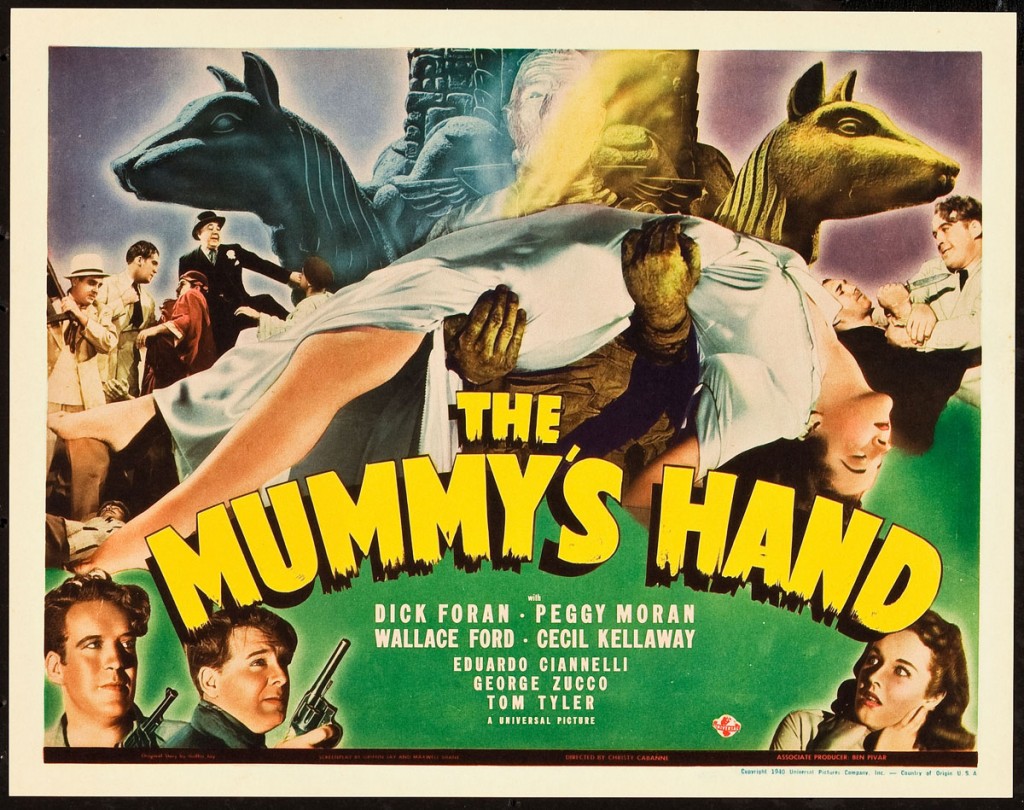 The Rules of the Kharis Mummy
The Rules of the Kharis Mummy
The first Kharis movie, The Mummy’s Hand, set in motion the formula for the rest. It established the undead murder-machine who was once the High Priest of Karnak. Similar to Imhotep in the 1932 film (and thus allowing for recycling footage from it), Kharis broke the laws of his priesthood by trying to resurrect his love, the Princess Ananka. For this sacrilege he was condemned to a living death. Kharis can be restored to (un)life through the series’s McGuffin, tana leaves. A brew of three tana leaves resurrects Kharis; nine makes him into a powerful killer who follows the orders of the current high priest of Karnak; and any more make him an unstoppable, soul-less killer. Sorry to say the promise of this overdose never occurs in any of the films. It’s a suspense device only: “No, don’t let him get the last of the tana leaves!”
The high priest who controls Kharis changes in each film, but the mission is usually identical: the priest resurrects Kharis with tana leaves and commands him to track down and kill all those damn dirty defilers of the Great God Karnak. Kharis complies, a few people die, then the priest makes a horrible error and gets himself killed. Kharis goes up in flames or sinks into mud, only to rebound in the next film none the worse for wear.
The Mummy’s Hand (1940)
The first in the revivified series, The Mummy’s Hand, isn’t much of a horror film. It’s an adventure story that has more in common with the 1999 Mummy than Boris Karloff. Kharis doesn’t even rise until forty-two minutes into the sixty-six-minute runtime. But the audience doesn’t have much chance to get bored, thanks to the energetic pacing. There’s even a big bar brawl! At times the film has too much energy, like the aggravating comic relief character played by Wallace Ford with awful Brooklyn mugging.
Where the other Kharis films have reactive protagonists who are living a genteel life until Kharis and the high priest of record come along to do some slow-motion killing, The Mummy’s Hand has active heroes on an archaeological hunt. Steven Banning (Dick Foran) is the handsome hero who has traveled to Egypt after losing his job at the Scripps Museum in New York. Like any good colonial looter, he’s hoping for a major archaeological find he can take back the U.S. to boost his career. He and his partner Babe (Ford) find a vase in a Cairo market that may lead them to the tomb of Princess Ananka. To get funding, they convince an adorable old stage magician, Dr. Solvani (Cecil Kellaway, who’s much funnier than Wallace Ford as comic relief), to pay for the expedition. Solvani’s feisty daughter — the type the 1940s loved — Marta (Peggy Moran) insists on coming along because she believes Banning is out to swindle her father.
Once the cast assembles in the desert to start excavating for Anaka’s tomb, High Priest Andoheb (George Zucco) sics Kharis (Tom Tyler) on the digging crew. Unfortunately, Kharis only strangles a few minor characters and allows Babe to live, angering the audience. Despite Babe’s survival, the last twenty minutes of the film are exciting material. The massive temple set, reused from the jungle adventure film Green Hell, finally opens up the picture with a touch of the Egyptian epic.
Tom Tyler was a regular in B-Westerns throughout the ‘30s and ‘40s, but racked up two impressive credits along the trail: Luke Plummer in Stagecoach (the man waiting for John Wayne in Lordsberg) and the first comic book superhero to reach the screen, Captain Marvel, in his eponymous movie serial — arguably the best serial of all time. Tyler has the stature to play Kharis, but doesn’t bring anything else to the part aside from being tall.
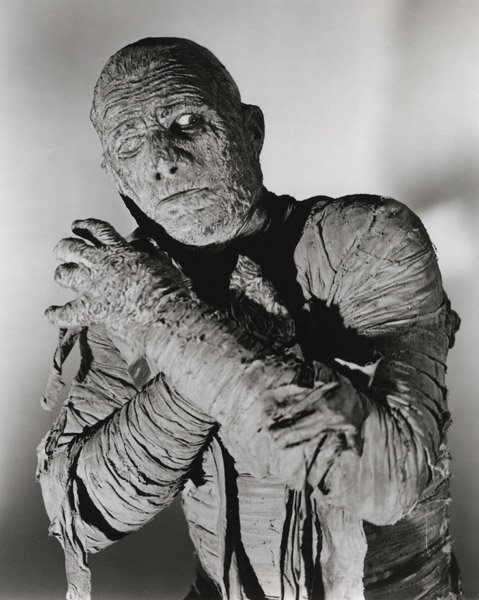 The true villain duties belong to George Zucco, one of the finest Universal contract players when it came to evil masterminds. Without Zucco’s delight in playing a cunning villain, The Mummy’s Hand would sag dangerously in its middle. Zucco only made brief returns to the series, playing a decrepit Andoheb for a single scene each in the next two sequels. I’m not sure how Andoheb survived having several bullets fired into him, but that’s a minor complaint compared to some of the other continuity crackpottery coming up. Kharis is incinerated at the climax, but pops up looking fine — as far as being a three thousand year-old rotting dead man goes — in The Mummy’s Tomb with no explanation whatsoever. So I think we can allow Andoheb living through a couple of bullets if it means a bit more George Zucco.
The true villain duties belong to George Zucco, one of the finest Universal contract players when it came to evil masterminds. Without Zucco’s delight in playing a cunning villain, The Mummy’s Hand would sag dangerously in its middle. Zucco only made brief returns to the series, playing a decrepit Andoheb for a single scene each in the next two sequels. I’m not sure how Andoheb survived having several bullets fired into him, but that’s a minor complaint compared to some of the other continuity crackpottery coming up. Kharis is incinerated at the climax, but pops up looking fine — as far as being a three thousand year-old rotting dead man goes — in The Mummy’s Tomb with no explanation whatsoever. So I think we can allow Andoheb living through a couple of bullets if it means a bit more George Zucco.
The Mummy’s Tomb (1942)
Two years passed before Universal made a direct sequel to The Mummy’s Hand. But in-universe, three decades have gone by, which means The Mummy’s Tomb ostensibly takes place in 1970. Of course, it looks exactly like 1942 because Univeral wasn’t worried about continuity — nor were audiences. For those who missed The Mummy’s Hand, the sequel fills them in with an interminable eleven minutes of repeated footage as a prologue. Wise old Steven Banning (Dick Foran in light old-age makeup) retells the plot of the previous movie for the benefit of his son John (John Hubbard) and his fiancée Isobel (Elyse Knox) at their mansion in Mapleton, Massachusetts. Already, the dropping budget is creating problems. Forget Egypt: we’re staying here in exotic Massachusetts on standing sets! If you want Egypt, we have some stock footage.
The new priest of Karnak, Mehmet Bey (Turhan Bey), brings Kharis (now played by Lon Chaney Jr.) to life in order to enact vengeance on the Banning family. In classic horror movie tradition, if you live through the original, you die in the sequel: both Dick Foran and Wallace Ford are strangled by the slooooow moving Kharis before a torch-wielding mob from central casting burns up the shuffling Egyptian in a house fire. (Wallace Ford strangely isn’t annoying comic relief this time. Fake old age must have mellowed him out.)
The Mummy’s Tomb looks cheaper than its predecessor, with much of the action occurring on pre-existing sets that have hardly any additional art direction to disguise them. At one point, Kharis lumbers onto what is obviously an Old West town set; the production must have sneaked in during the evening between shooting days on a Johnny Mack Brown flick. This kind of slothful art direction sucks out the majesty and romance of Ancient Egypt that is at the core of the appeal of a mummy movie. At least it moves fast, ditches the terrible comedy, and gets audiences out after a mere sixty-one minutes — of which only fifty were actually shot for the movie.
Universal put their biggest current monster star under the Kharis wrappings, Lon Chaney Jr. He’d stay in the bandages for the rest of the series. Chaney often bragged about how he was the sole actor to play all four of the studio’s classic monsters: the Wolf Man, Dracula, Frankenstein’s Monster, and the Mummy. But he hated playing Kharis and never lost an opportunity to complain about how thankless the part was. This dislike, unfortunately, spills onto the screen. Chaney is so clearly bored as he lumbers around the sets, making Kharis’s already motion-impaired threat level feel like a joke. When people quip about how elderly folks with walkers could outrun the mummy, they’re thinking of Chaney’s mummy.
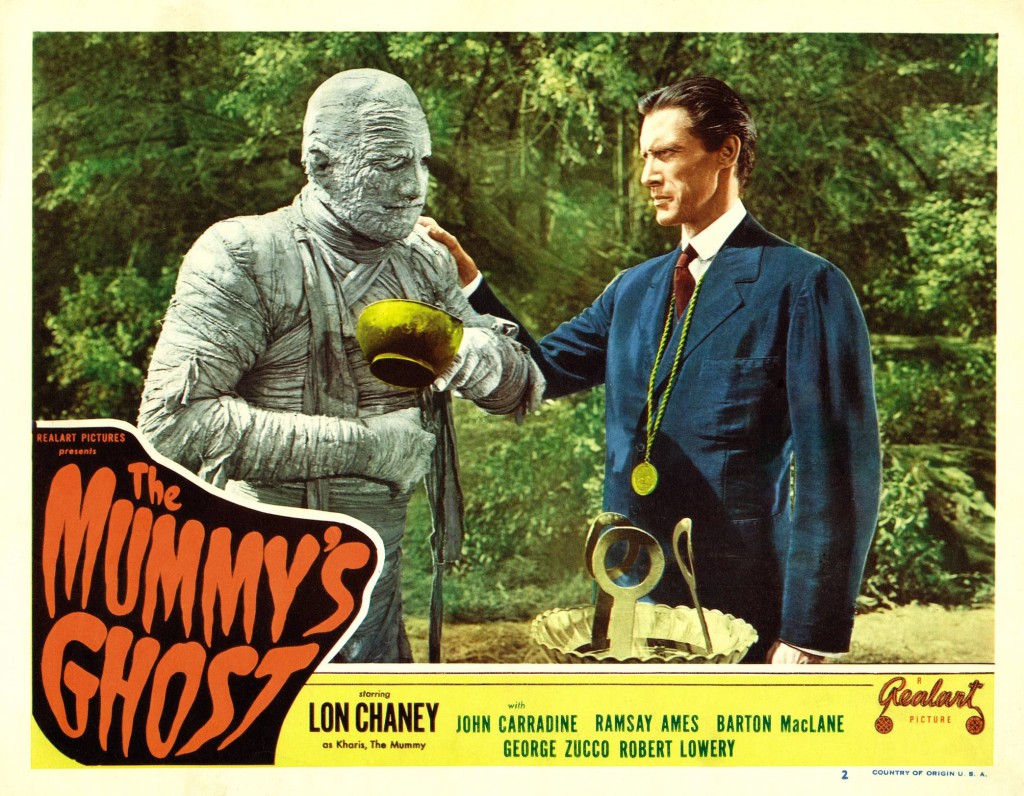 The bright spot is again the high priest of Karnak. (Get used to this phrase.) Turhan Bey, a half-Czech half-Turkish actor who played leading men roles in ‘40s Universal pictures, provides a romantic exoticism to High Priest Mehmet Bey. The priest’s obsession with young Isobel is the sole interesting drama the movie has away from the ritualized mummy-go-kill action. The scene where Mehmet Bey demands Kharis go on a mission to fill his own lust, breaking his priestly vows, is the film’s highlight. This is the only time Chaney actually got to do anything approaching acting as Kharis, and the subtle play between him and Bey is quite good.
The bright spot is again the high priest of Karnak. (Get used to this phrase.) Turhan Bey, a half-Czech half-Turkish actor who played leading men roles in ‘40s Universal pictures, provides a romantic exoticism to High Priest Mehmet Bey. The priest’s obsession with young Isobel is the sole interesting drama the movie has away from the ritualized mummy-go-kill action. The scene where Mehmet Bey demands Kharis go on a mission to fill his own lust, breaking his priestly vows, is the film’s highlight. This is the only time Chaney actually got to do anything approaching acting as Kharis, and the subtle play between him and Bey is quite good.
The Mummy’s Ghost (1943)
The Kharis series hit the bottom of the Well of the Souls with its next installment. That it manages this feat with none other than John Freakin’ Carradine playing the villainous priest must have taken immense effort. The Mummy’s Ghost is a tedious chore, directed with all the thrill of an industrial short about safe bandage care. Although it clocks in at another merciful sixty-one minutes, it feels like three times that length.
The Mummy’s Ghost takes place five years after The Mummy’s Tomb … so I guess it’s 1975 now? The action is still in Massachusetts, centered around Scripps University — apparently no longer a museum. The new high priest of Karnak — no, wait, he’s the high priest of “Arkam.” Did Karnak retire and Arkam take over his accounts? Anyway, High Priest Yusef Bey learns that Kharis is still alive, despite having gone through a second incineration. Kharis receives no build-up at all: the mummy simply stumbles from the underbrush onto a road when the first batch of tana leaves is brewed. Are you getting a sense of how lazy this all is?
Although Princess Ananka received plenty of mention in the previous films, this is the first one to introduce the idea that she has been reincarnated as a modern woman. This comes straight from the 1932 movie, and it’s odd the Kharis series took so long to take out this idea and play with it. Not that it helps The Mummy’s Ghost much. Ananka’s modern form is college student Amina Mansouri (Ramsay Ames), a girl of Egyptian descent who has a minor panic attack whenever anyone mentions Egypt. Ames brings nothing to the role, and her college boyfriend Tom Hervey (Robert Lowery) is the biggest zero as far as “heroes” go in the series.
And here we go again … the bright spot is the high priest. Yes, John Carradine is here to make viewers want to struggle through to the end so they can enjoy one of the Great Voices, a fellow who can command attention among even the dullest proceedings. The only sequence in the film that can be said to work is Yusuf Bey holding a ceremony over Ananka’s sarcophagus in the Scripps Museum while Kharis watches. This is the sole place in the movie anything Egyptian appears, but it’s Carradine’s authority holding it together.
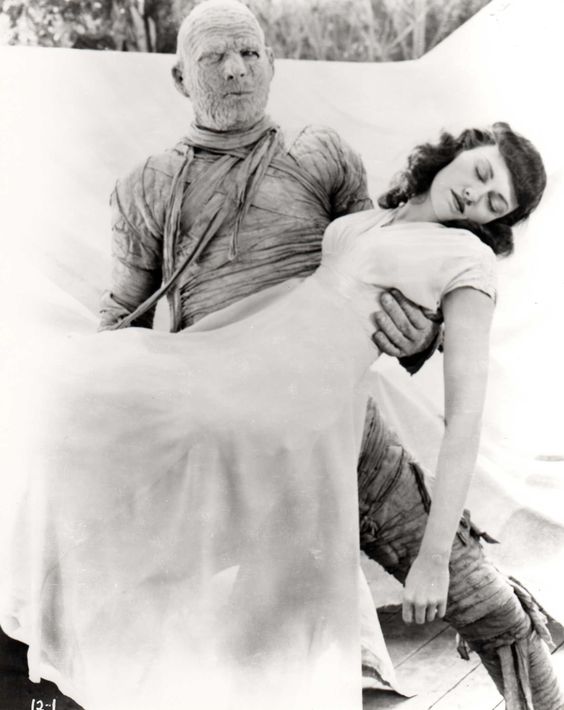 The Mummy’s Ghost closes with one of the most annoying climaxes imaginable. During the sunniest night in history, Kharis stumbles across the dusty Western prairies and oil wells of Massachusetts while a crowd follows him (or are edited to appear to follow him) and a little dog yaps and yips and yaps as library music comically tries to pretend all this is exciting. Kharis sinks into a swamp with Amina in his arms. It’s a bleak closer for one of these movies, yet it has no impact at all. It’s astonishing Universal went ahead and made another film after this. But nine months later…
The Mummy’s Ghost closes with one of the most annoying climaxes imaginable. During the sunniest night in history, Kharis stumbles across the dusty Western prairies and oil wells of Massachusetts while a crowd follows him (or are edited to appear to follow him) and a little dog yaps and yips and yaps as library music comically tries to pretend all this is exciting. Kharis sinks into a swamp with Amina in his arms. It’s a bleak closer for one of these movies, yet it has no impact at all. It’s astonishing Universal went ahead and made another film after this. But nine months later…
The Mummy’s Curse (1944)
Considering how depleted the series felt after The Mummy’s Ghost, it’s impressive the last sequel rebounded and delivered the best of the Chaney-starring films. Chaney doesn’t get the credit for the save; some folks at Universal’s B-movie division decided these films didn’t have to be terrible just because they were cheap, and put effort into this one even as the monster cycle was winding down. It’s strange Kharis didn’t migrate over into the Monster Rally films House of Frankenstein and House of Dracula, but those pictures were crowded enough.
By the in-universe reckoning of years, The Mummy’s Curse takes place in the year 2000. The swamp where Kharis sank has leaped across the country from Massachusetts and landed in Cajun bayou country. However, I’ll take it, because the swamp setting allows for actual atmosphere. Throughout the standard mummy proceedings, the film is sprinkled with touches of bayou color and eccentric supporting characters. This is how you put a pool of skilled contract players to use.
Yet another high priest, Ilzor (Peter Coe), has come to revive Kharis for nefarious plans. He also revives footage from earlier films, in which both Tom Tyler and Boris Karloff appear as Kharis. I wonder if Lon Chaney was annoyed at this. Ilzor and his servant Ragheb (Martin Kosleck) take up headquarters in one of the many abandoned Gothic monasteries strewn all over the Louisiana bayous. Once again, I’ll take it: it’s nice to have creepy ruins of any kind in a Universal monster film. Ilzor whips up a brew of tana leaves and Kharis is back in business.
But Ananka returns as well in what is the visual high point of the series — and one of the best moments in any mummy film, full stop. Ananka (now played by Virginia Christine) crawls up from the deeps of the swamp, and as the sun bakes her, Jack Pierce’s makeup passes through several different stages of drying and cracking. Ananka claws her way through a pond and emerges on the other side as a pristine young woman. It’s a gorgeous set-piece and shows Universal still had a bit of the old black magic left even in the twilight of the monsters.
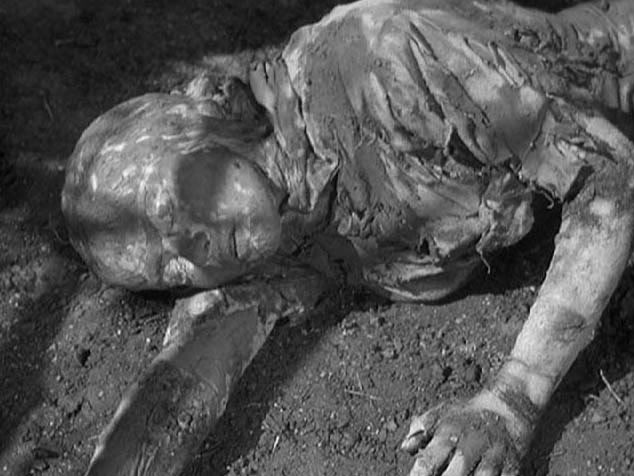 For once, the high priest isn’t the bright spot of the movie. Peter Coe is bland and monotone as Ilzor; Kosleck’s stab-happy Ragheb steals all their scenes. It’s Virginia Christine who carries away the picture. Ramsay Ames was a non-entity as the reincarnated Ananka, while Christine is radiant and otherworldly. This is the first time since the 1932 Mummy that anyone has projected a sense of the mystery of the lost world of the Kingdom of the Nile.
For once, the high priest isn’t the bright spot of the movie. Peter Coe is bland and monotone as Ilzor; Kosleck’s stab-happy Ragheb steals all their scenes. It’s Virginia Christine who carries away the picture. Ramsay Ames was a non-entity as the reincarnated Ananka, while Christine is radiant and otherworldly. This is the first time since the 1932 Mummy that anyone has projected a sense of the mystery of the lost world of the Kingdom of the Nile.
With all The Mummy’s Curse has in its favor, it’s a shame Lon Chaney’s Kharis remains so damned uninteresting and un-scary. He manages to kill a few people on screen — almost nothing happened on-screen in The Mummy’s Ghost — but it’s amazing he manages to kill anybody considering how listless he acts. The costume has declined as well; it looks like Chaney is only wearing a rumpled shirt.
I don’t know how The Mummy’s Curse managed to rise up beyond the previous two Chaney-starring flicks, but it was a good way to close the series. It even ends on a definitive note: there’s nothing more of the tale of Kharis and Ananka to tell after this.
Wrapping Up Kharis (Sorry, Had to Do It)
The Kharis legacy remains with us to this day. Even though the 1999 Mummy used the name Imhotep for its immortal Egyptian villain, the film couldn’t avoid the the wrapped-up mummy iconography; viewers expected it. The Kharis films also led to a 1959 remake from Britain’s Hammer Film Productions — a remake that took elements from all four movies and seasoned them with the mysticism of the 1932 original to create what I consider the greatest mummy film of all time. That’s what I’ll be looking at next week, because even if this new Tom Cruise Mummy smells like the inside of a used canopic jar, I can still squeeze an extra blog out of its existence. How much an excuse do I need to talk about Peter Cushing?
You can purchase all of the Kharis movies, as well as the Boris Karloff classic, in the current The Mummy: The Complete Legacy Collection Blu-ray set. Unlike many other Universal Legacy Collections, this one doesn’t have overlap with other sets, making it one of the better deals — even if only one of the films in the set is a bonafide classic. If the only movie you find yourself rewatching is the 1932 one, that’s not a bad bargain. If you want to dip your toes into the Nile waters of the Kharis films to see if they’re to your liking, they’re also available on multiple streaming services.
Ryan Harvey is one of the original bloggers for Black Gate, starting in 2008. He received the Writers of the Future Award for his short story “An Acolyte of Black Spires,” and his stories “The Sorrowless Thief” and “Stand at Dubun-Geb” are available in Black Gate online fiction. A further Ahn-Tarqa adventure, “Farewell to Tyrn”, is currently available as an e-book. Ryan lives in Costa Mesa, California where he works as a professional writer for a marketing company. Occasionally, people ask him to talk about Edgar Rice Burroughs or Godzilla in interviews.
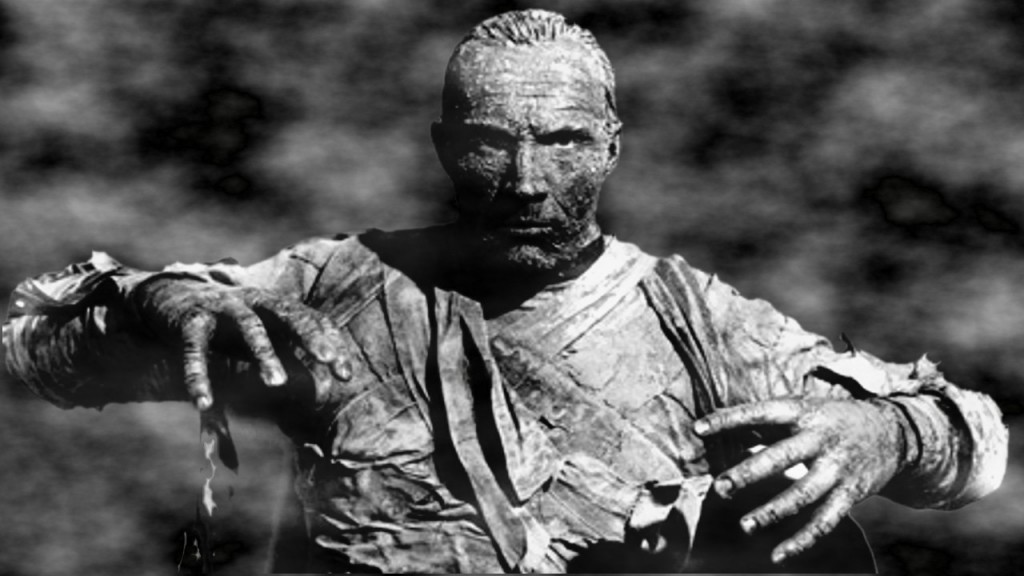
The Complete Legacy Collection is also on DVD (in its new packaging). It’s my intention to watch the appropriate classic Universal and Hammer movies every time one of these Dark Universe movies comes out, as a way of celebrating not going to the new one. Last night I watched the documentary “Mummy Dearest: A Horror Tradition Unearthed”. Over the next week or so I plan to watch the Karloff movie, all the movies you mentioned above, the Lee/Cushing movie, and Blood from the Mummy’s Tomb.
I’ve always found the post-Karloff mummy movies of the 40’s to be nothing more than passable Saturday afternoon fare, but Karloff’s version is by far my favorite of the original Universals – eerie, poetic, in love with death.
Actually though, there’s nothing wrong with passable Saturday afternoon fare, so…I think I’ll watch The Mummy’s Hand right now. C-ya!
[…] The Massachusetts Mummy: Universal’s Kharis Mummy Movies by Ryan Harvey – https://www.blackgate.com/2017/06/10/universals-kharis-mummy-movies/ […]